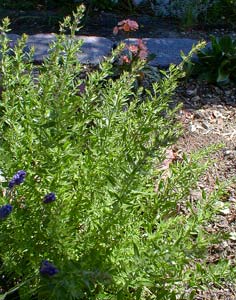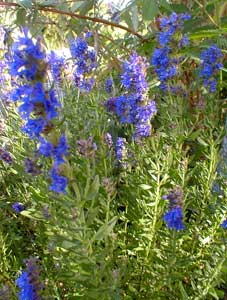
Dwarf Blue Hyssop
"Be those impressions which incline the heart
To mild, to lowly, & to seeming weak,
Bend that way her desires. The dew, the storm--
The dew whose moisture fell in gentle drops
On the small hyssop destined to become,
By Hebrew ordinance devoutly kept,
A purifying instrument."
-William Wordsworth
April 1837
"To purify the house he is to take two birds
& some cedar wood, scarlet yarn & hyssop."
Leviticus 14:49
April 1837
In 2002 I planted a small start of a Dwarf Blue Hyssop in a harsh sun-garden under an elkhorn sumac. Though extremely drought tolerant, this one experienced a terribly harsh first summer before it had a chance to get established, & it appeared for all the world as though it died that summer. To my surprise it returned to life in Autumn, so I knew that the following year it was going to be okay.
The photo above shows its June foliage, low growing & lush at the base of an Elkhorn Sumac. The second photo shows it in July with its blue flowers. It has spread quite a lot from the wee plant it began as, & has spread right into a Hidcote Lavender which has flowers close to the same color, & about the same height, but they still contrast nicely because of different textures.
The dwarf blue hyssop wants full sun though in hotter zones than ours it won't mind some shade. It requires perfect drainage, & is easily harmed by overwatering. It is both cold-hardy & heat-hardy. In areas where the winter temperatures are extremely cold, it dies to the ground, but even where winters get down to minus thirty degrees F., it will return the following spring good as new. In our temperate zone it has a semi-evergreen habit, but should be cut back nearly to the ground in spring, then given a little fertilizer at that time in order to start anew.
 It grows to only a foot of height, about half the size of the species. 'Nana' means "Dwarf" & this dwarf was cloned from the naturally occurring Hyssoppus officinalis var decumbens. A similar dwarf variant is sold as 'Aristata' & is a clone of H. officinalis var aristata.
It grows to only a foot of height, about half the size of the species. 'Nana' means "Dwarf" & this dwarf was cloned from the naturally occurring Hyssoppus officinalis var decumbens. A similar dwarf variant is sold as 'Aristata' & is a clone of H. officinalis var aristata. Dwarf Blue Hyssop's small blue summer flowers attract butterflies & bees & are fragrant & beautiful. The leaves are fragrant too. Cuttings for indoor bouquets bring a wonderful spicy scent into the kitchen or dining room.
H. officinalis is very old as a folk medicine for colic, flatulance, indigestion; or taken as a hot tea for bronchial infections; or used topically on cuts & burns. The antimicrobial properties of hyssop have been subjected to controlled studies & it is one of the more credible medicinal herbs. Unfortunately it has also been known to induce convulsions. So to keep from being sued for harming people, all powdered hyssop sold in health food stores have negligible active ingredients & no medicinal value, being little more than ground up & very stale garden rubble. That at least means the commercially packaged offerings won't induce the side-effects that are possible with the freshly prepared herb or pure exracts, but the safe commercial garden rubble is also worthless for such health purposes as may be legitimate with the fresh herb.
In small amounts, of course, it is totally harmless even fresh, & has been widely used as a culinary herb. It is good particularly in stews. It's somewhat bitter & not so tasty in large amounts or on salads. It is the distinguishing ingredient in the liqueur Chartreuse.